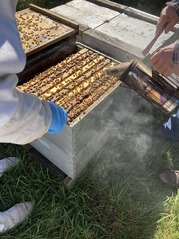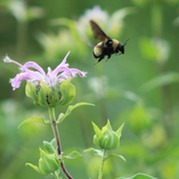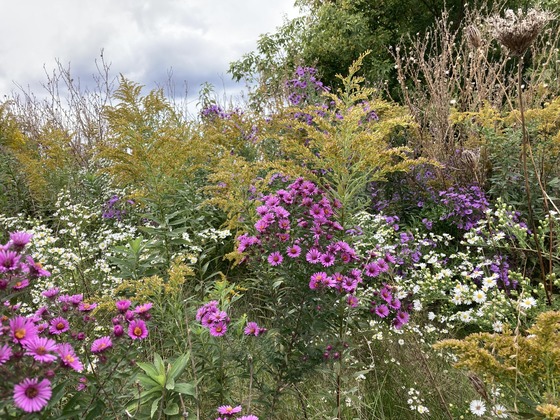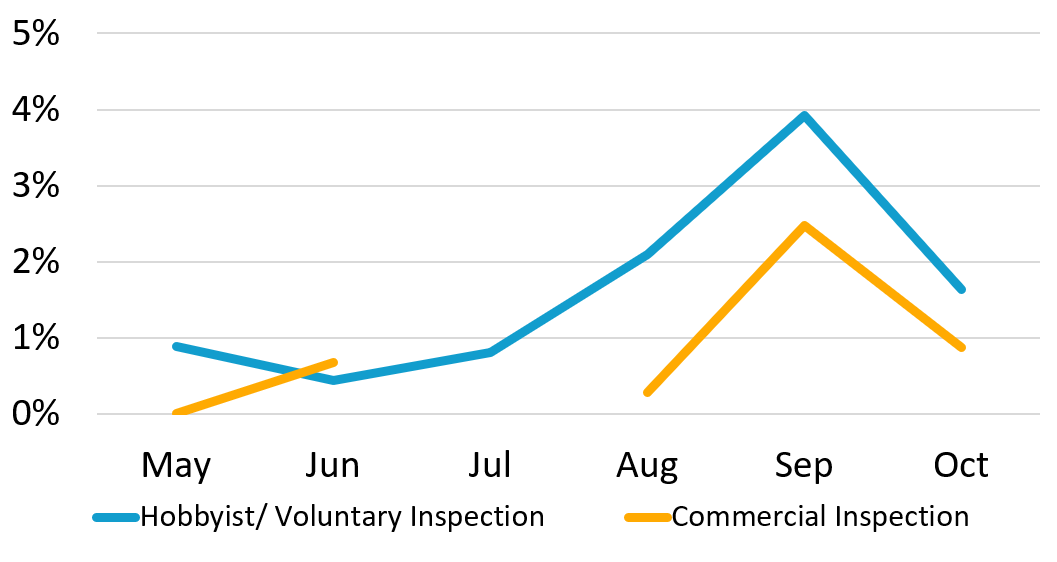|
|
Dear Wisconsin honey bee and pollinator fans:
Happy New Year! This is the first quarterly update of 2024 from the Wisconsin Department of Agriculture, Trade and Consumer Protection’s (DATCP) apiary program. First off, we want to let you know that Frances Hegarty will be leaving her position as an apiary coordinator with DATCP in mid-January. Frances was hired with DATCP as a seasonal licensing associate for the Weights and Measures Bureau in 2015, and then as a licensing specialist for the Plant Industry Bureau's nursery program in 2016 before serving as our Hemp Program Coordinator from 2018-21, and our apiary coordinator from 2022-23. We thank Frances for her dedicated service to the department over the past eight years and we wish her well in her new endeavors. We anticipate recruiting a new apiary coordinator within the next few months, so please watch for that opportunity, and contact Plant Protection Section manager Shahla Werner at shahla.werner@wisconsin.gov with any apiary program ideas or concerns in the meantime.
|
|
|
Anyone who moves honey bees or used beekeeping equipment into Wisconsin is reminded that if you plan to bring honey bees (or used equipment) into Wisconsin this year, you must do the following:
- Fill out and submit the Wisconsin Honey Bee Import Report (HBIR) form before the honey bees or used beekeeping equipment arrive in Wisconsin.
- Provide a valid inspection certificate. The certificate must be issued within 12 months before arrival to Wisconsin. The certificate must be issued by either Wisconsin or another state.

Wisconsin state law (Wis. Stat. § 94.76(4) and Wis. Admin. Code § ATCP 21.13) says that this reporting requirement applies to anyone who moves honey bees or used beekeeping equipment into Wisconsin. This can include beekeepers who provide honey bee pollination services, migratory beekeepers, beekeepers who move to Wisconsin with their honey bees, and honey bee providers who send nucleus colonies (or “nucs”), honey bee packages, or queens to Wisconsin.
|
Photo (above): Honey bees colonies along an agricultural field.
At least one valid Certificate of Apiary Inspection must be submitted with a Wisconsin HBIR form and the certificate must verify the following:
- Colonies are free of American foulbrood.
- Bees are of European honey bee stock.
Links to Wisconsin Honey Bee Import Report (HBIR) resources:
|
|
|
If you are moving honey bees or regulated honey bee materials, such as hives or equipment, out of Wisconsin, the state that you are moving them to might require that you obtain a Wisconsin Apiary Certificate of Inspection from DATCP.
Before you move your honey bees (or any other regulated honey bee materials) into another state, you should first verify that state’s requirements with their local apiary inspection service.
Then, if you need a Wisconsin certificate, schedule a Wisconsin commercial apiary inspection and request a Wisconsin certificate. To schedule a Wisconsin apiary inspection, contact a DATCP apiary inspector to set up an appointment. Appointments are available on a first-come, first-served basis from May - October, each year. Finally, you will need to pay $50 for each Wisconsin certificate, as required by state law (Wis. Admin Code § ATCP 21.05(3)(a)). |
|
 |
Photo (above): Honey bee hive during a commercial inspection.
|
|
|
By Judy Cardin, Wisconsin Bumble Bee Brigade Trainer
Gardening Tips:

- Provide good nesting and hibernation locations by leaving leaves, plant stems, sticks, rodent holes, grass mats, etc.*
- Plant native flowers that will provide blossoms from April - October.
- Don’t use pesticides, especially when flowers are blooming.
|
Photo (above): Bumble bee and wild bergamot bloom - USFWS, Courtney Celley.
Flower Ideas Across the Seasons:
April - May: Include native woodland spring ephemerals/flowers, fruit trees, and shrubs. As native bee queens emerge in the spring and start their nests, great flowers include Dutchmen’s breeches, Virginia bluebells, bellwort, Jacob’s ladder, shooting star, trout lily, Virginia waterleaf, American plum, pussy willow, prairie willow, currants, and gooseberries. If you do not have a woodland, you can create a woodland environment under the drip line of a native tree. First, smother turf grass under the tree (overlap non-sheen cardboard, weighted down with rocks and covered with wood mulch). Then, gather leaves under the tree and allow the accumulation of natural habitat builders such as plant litter, twigs, branches, rocks, and leaves. Eventually, the decomposing organic material creates a rich humus soil, but you can plant flowers before that happens.
June - July: Early summer native blooms include anise hyssop, coreopsis, great St. John’s wort, shrubby St. John’s wort, bearded foxglove, wild bergamot (bee balm), wood betony, Canada milk vetch, swamp milkweed, wild lupine, white false indigo, cream false indigo, pale purple coneflower, culver’s root, native roses, mountain mint, senna, and Joe-Pye weed.
August - September: Late summer/early fall native blooms include asters, goldenrods, obedient plant, turtlehead, great blue lobelia, and blue sage. In Wisconsin, New England asters can sometimes bloom into October.
* Should I buy bee hotels? Instead, create habitat for stem nesting bees by leaving plant stems in the fall, and trim them to varying heights of eight to 24 inches in the spring.
Want to learn more and contribute to community science? Join the Bumble Bee Brigade!
 Photo: Aster and goldenrod blooms in the fall.
|
|
|
2023 was a busy (buzzy!) year for DATCP's apiary program! We conducted 165 voluntary inspections, 47 commercial inspections, and opened 1,207 honey bee hives across Wisconsin. In addition, the apiary program issued 56 certificates of apiary inspection for about 34,500 migratory hives, primarily destined to California and Texas for pollination services.
2023 Highlights:
- 1,207 hives opened
- 165 voluntary/hobbyist inspections
- 47 commercial inspections
- 56 Certificates of Apiary Inspection issued
- 24 National Honey Bee Survey (NHBS) inspections
- 44% winter mortality reported during voluntary inspections
 Map: 2023 Wisconsin apiary program inspection locations. GPS coordinates were not captured at all commercial inspection locations, so not all commercial inspection locations are included on this map.
In 2023, the apiary program also introduced electronic data collection and PDF inspection reports for the voluntary/hobbyist inspections. These PDF inspection reports were emailed (or mailed) to beekeepers. Compared to the program’s 2022 inspection findings, the 2023 inspections found increases in several honey bee pests and diseases. The incidence of European foulbrood increased from 0.36% to 1.24%; sacbrood virus increased from 2.20% to 3.14%; and deformed wing virus increased from 1.42% to 4.89%. Also, American foulbrood increased from zero cases in 2022 to 0.08% of hives inspected in 2023. In contrast, Varroa mite incidence decreased from 58% in 2022 to 41% in 2023; and small hive beetle decreased from 2.13% to 0.25%. As reported via our voluntary survey questionnaire to hobbyist beekeepers, colony winter mortality decreased from 68% in 2022 to 44% in 2023, exceeding the 2023 national average of 37%.
In 2023, the implementation of electronic data collection for the voluntary/ hobbyist inspections allowed for more efficient/accurate data collection and improved data analysis. As an example, the graph below shows the average Varroa mite rates per month during 2023.
 Graph: Wisconsin average 2023 Varroa mite rates per month, from Varroa mite counts conducted during inspections.
We are hopeful that the beekeepers who continue to receive inspection services and management information will be able to further reduce Varroa mite levels and overwintering mortality over time. To help with this, the Honey Bee Health Coalition (HBHC) has excellent honey bee health resources on their website, honeybeehealthcoalition.org.
For the 13th year, Wisconsin participated in the USDA APHIS National Honey Bee Survey (NHBS) to examine a subset of colonies for Varroa mites, Tropilaelaps mites, Nosema levels, viral pathogens, and other exotic pests. Samples were also taken to be analyzed for pesticide residues. To date, no Wisconsin samples have ever tested positive for Tropilaelaps spp., Apis mellifera capensis, or Slow Bee Paralysis Virus. Final data and pesticide test results for 2023 are pending. All NHBS data is available to the public on the Bee Informed Partnership research portal at https://research.beeinformed.org/state_reports.
We continued our apiary outreach in 2023. In addition to the information provided to beekeepers during inspections, we provided quarterly updates via this e-newsletter, attended the Wisconsin Honey Producers Association (WHPA) summer and fall meetings, the Wisconsin State Fair, various trade shows, and provided presentations to 17 local honey bee club meetings throughout the year. We look forward seeing Wisconsin beekeepers and their bees throughout 2024!
|
|
|
AmiFlex is a pesticide designated by the EPA as a Restricted Use Pesticide (RUP) product to treat honey bees for Varroa mites. AmiFlex is now registered for use in Wisconsin, and all Wisconsin AmiFlex applicators must be a Wisconsin certified pesticide applicator. If you plan to apply an RUP (like Amiflex) for another beekeeper in Wisconsin, you must be a certified pesticide applicator and have the appropriate Wisconsin pesticide license.
For more information, please see this FAQ about the RUP requirements for Wisconsin AmiFlex applicators.
|
|
|
|
|